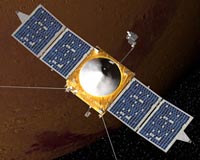 |
Dallas TX (SPX) Oct 18, 2010 Instruments designed by a UT Dallas professor to measure atmospheric components on the surface of Mars have uncovered important clues about the planet's atmosphere and climate history. The findings, published in a recent issue of the journal Science, reveal how carbon dioxide isotopes have reacted to volcanic activity, water and weathering - thus forming a more complete picture of the current Martian atmosphere. The NASA mission in which this work was accomplished was the Phoenix Lander, an unmanned spacecraft deployed to Mars in 2008. UT Dallas Physics Professor John Hoffman, a member of the William B. Hanson Center for Space Sciences, designed the mass spectrometer through which soil samples collected at the surface of Mars were analyzed. Samples of atmospheric gasses were drawn into the instrument during several Martian days, called "sols," and analyzed to determine the type of gases that comprise the atmosphere. "The dominant gas is carbon dioxide," Hoffman said. "We examined these carbon dioxide molecules and measured the ratio of the light to heavy atoms of carbon and oxygen." Different mass atoms of an element are called isotopes. By contrasting these isotopes, Hoffman and other researchers could see how the gases were affected by geologic processes on Mars. Previous samples from the Martian atmosphere were analyzed three decades ago during NASA's Viking program. The precision of those measurements was limited by the technology available at the time. "The accuracy of the current measurements far surpasses the previous information we had," Hoffman said. "Obviously, these geologic and atmospheric changes are slow processes, but we now have a better idea of the earlier planetary atmosphere." Scientists have also studied material from Martian meteorites that have landed on Earth. These data have helped fill in the time scale for the evolution of the atmosphere on Mars. "These findings are exciting because they show how the atmosphere of Mars evolved and we can contrast that to our own history here on Earth," Hoffman added. "We have a more complete understanding of our neighboring planet." The research was funded by NASA as part of the Mars Scout Program. The work was conducted in collaboration with researchers at the University of Arizona.
Share This Article With Planet Earth
Related Links UT Dallas Mars News and Information at MarsDaily.com Lunar Dreams and more
 Lockheed Martin-Built Spacecraft Will Be Next Orbiter At Mars
Lockheed Martin-Built Spacecraft Will Be Next Orbiter At MarsDenver CO (SPX) Oct 06, 2010 NASA's Mars Atmosphere and Volatile Evolution (MAVEN) project passed its Mission Confirmation Review on Oct. 4. As a result, NASA has given approval for the development and 2013 launch of the MAVEN mission. Lockheed Martin [NYSE: LMT] is the industry partner for the mission and will design and build the spacecraft and perform flight operations. This major milestone was the culmination of a ... read more |
|
| The content herein, unless otherwise known to be public domain, are Copyright 1995-2010 - SpaceDaily. AFP and UPI Wire Stories are copyright Agence France-Presse and United Press International. ESA Portal Reports are copyright European Space Agency. All NASA sourced material is public domain. Additional copyrights may apply in whole or part to other bona fide parties. Advertising does not imply endorsement,agreement or approval of any opinions, statements or information provided by SpaceDaily on any Web page published or hosted by SpaceDaily. Privacy Statement |